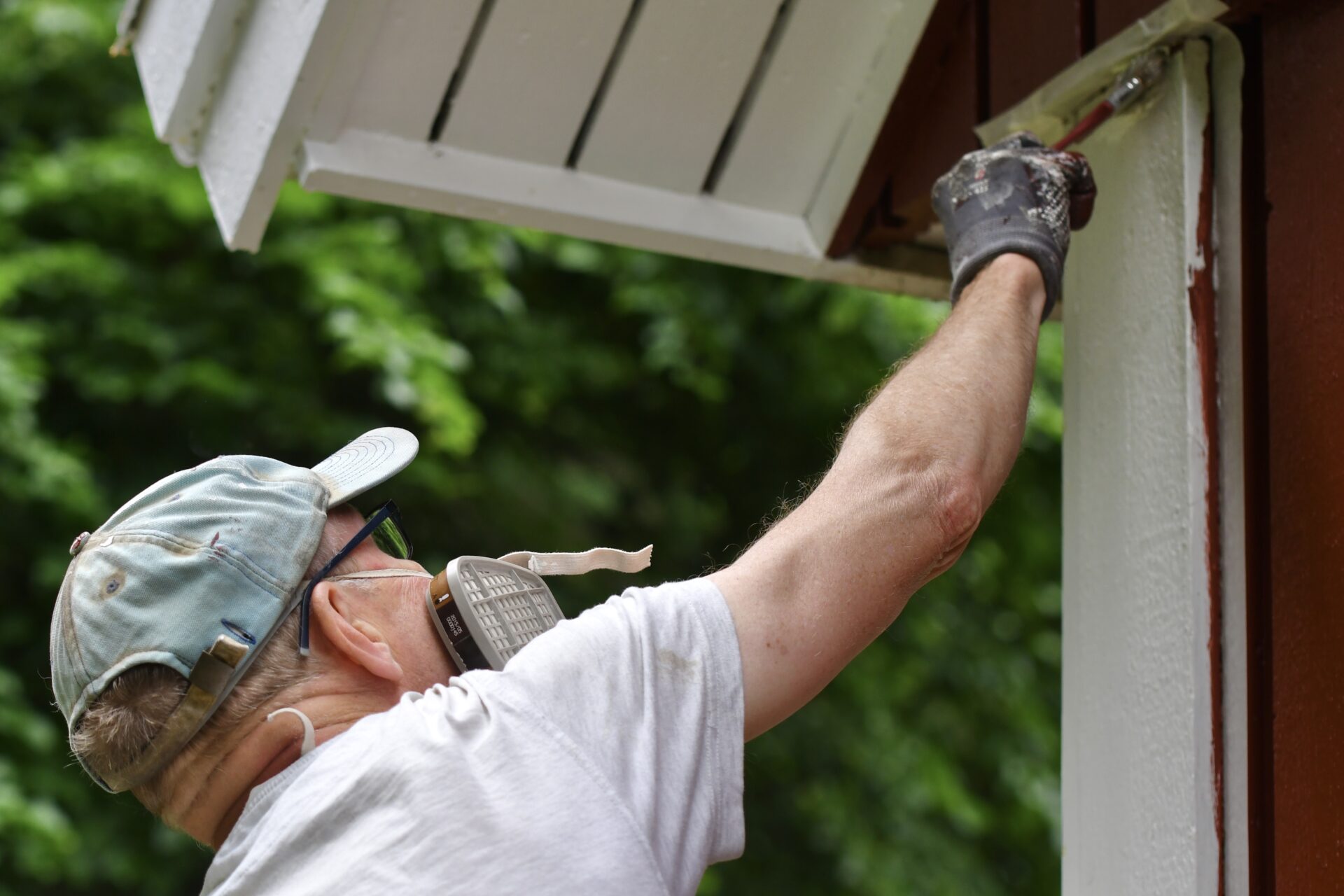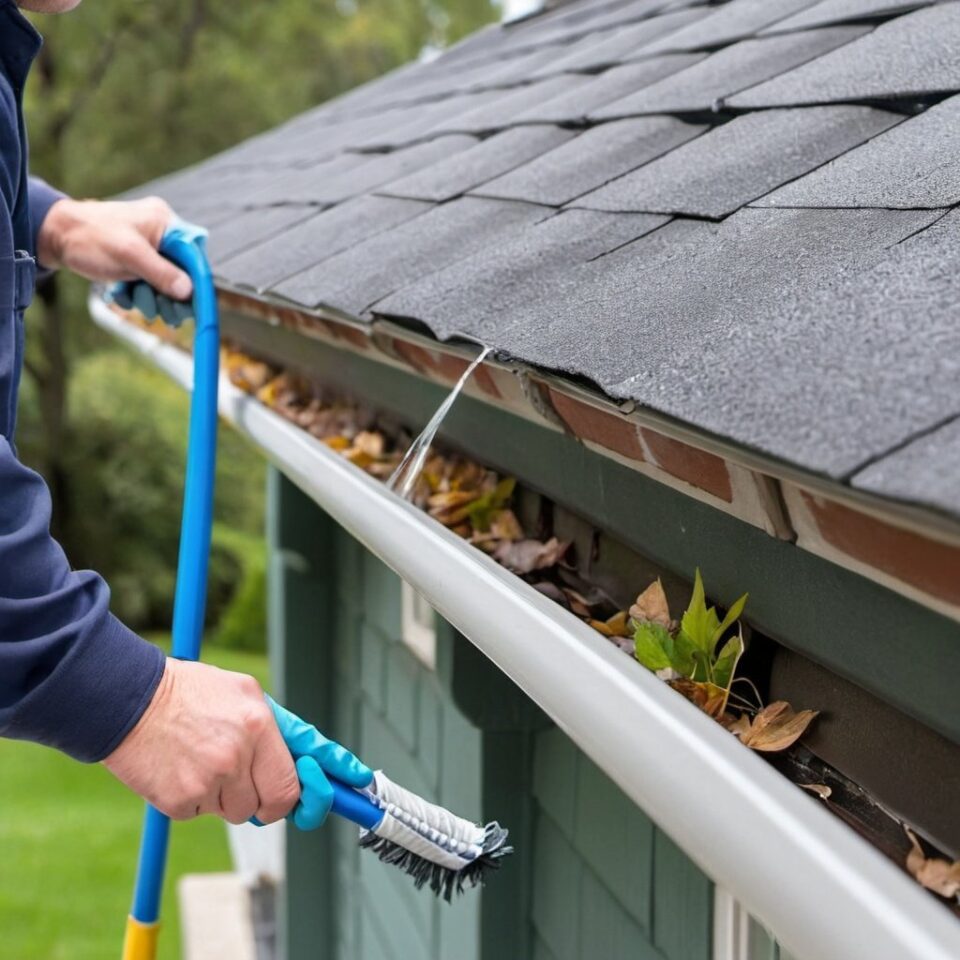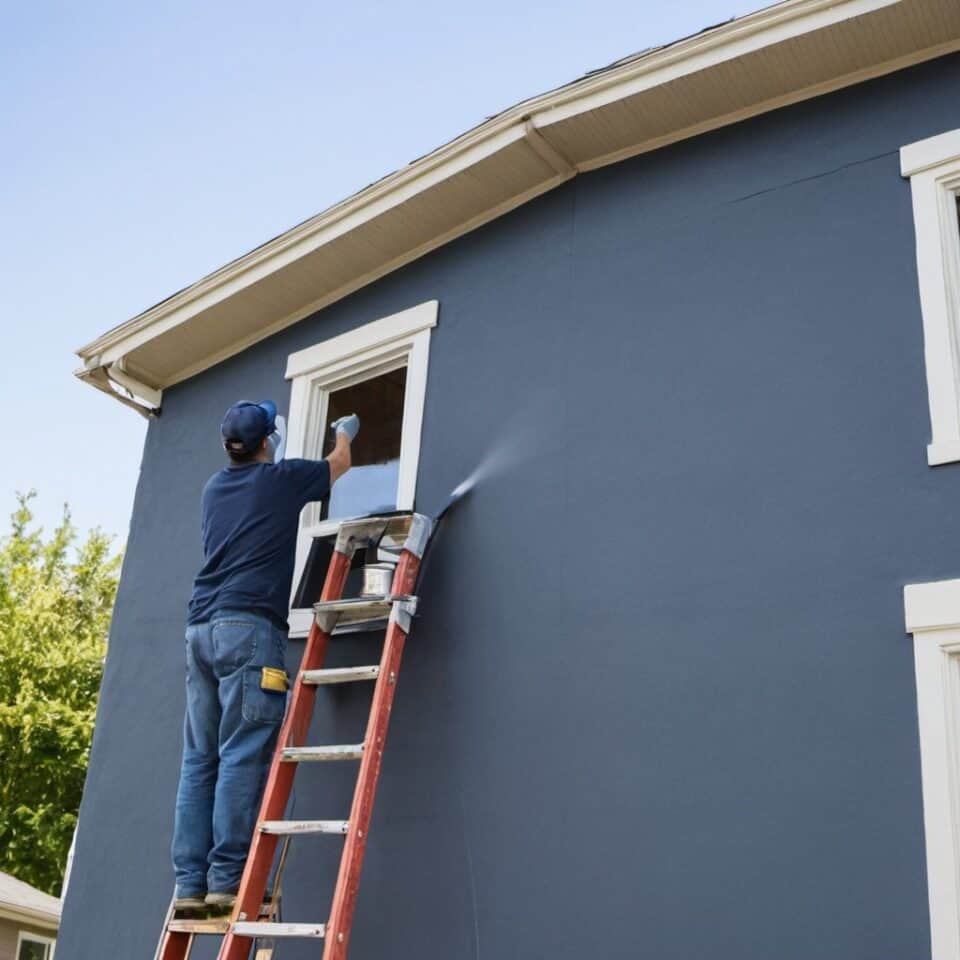In the realm of home maintenance, one key factor stands out as the linchpin for a paint job that not only looks stunning but also withstands the test of time – prep work. In this article, we delve into the crucial art of preparation and its pivotal role in extending the lifespan of an exterior paint job.
Exterior painting is not just about enhancing your home’s curb appeal; it’s also about protecting it from harsh weather conditions. Therefore, it’s essential to understand how often you should paint your house exterior to ensure your home is adequately protected. But, before you grab your paintbrush and head outside, it’s crucial to emphasize the importance of proper preparation. Skipping this critical step can result in a shorter lifespan of your exterior paint job and the need to repaint sooner than expected.
Key Takeaways:
- Proper preparation is crucial for a long-lasting exterior paint job.
- Factors such as climate, previous quality, and siding condition determine how often to paint the house exterior.
- The signs indicating it’s time to repaint include fading color, peeling paint, and cracks in the paint.
- Choosing the right paint, painting in optimal weather conditions, and applying best practices can help to extend the lifespan of your exterior paint job.
- Weigh the pros and cons of hiring a professional painter versus completing the exterior painting project yourself.
Understanding the Factors That Determine Painting Intervals
It’s natural to wonder how often you should paint your house exterior. In reality, there isn’t a one-size-fits-all answer. Various factors influence the painting intervals for each home, making it necessary to assess your situation before deciding on a timeline.
Climate
Where you live plays a significant role in determining how often you’ll need to paint your home’s exterior. Harsh weather conditions, such as extreme heat or cold, strong winds, and heavy rainfall, can cause paint to deteriorate more quickly, leading to more frequent painting needs.
Quality of Previous Paint Job
The quality of the previous paint job will also determine how often you should repaint your home’s exterior. A poorly done painting job can cause peeling or blistering, which increases the likelihood of needing to repaint more frequently. If your previous paint job was of high quality and used premium paint, you may be able to go longer between painting jobs.
Condition of Siding
The condition of your home’s siding is another critical factor to consider when assessing your painting intervals. If your siding is in good condition, you may be able to go longer between painting jobs. However, if your siding is damaged, rotting, or experiencing wear and tear, you’ll likely need to repaint more frequently.
Recommended Exterior Painting Timeline
As a general rule, experts recommend repainting your home’s exterior every five to ten years. However, you’ll need to assess the aforementioned factors to determine the optimal timeline for your situation.
Considering these factors can help you determine how often you should paint your house exterior. By creating a painting plan that best suits your needs, you can maintain your home’s curb appeal and protect it from the elements for years to come.
Signs that Your House Exterior Needs Repainting
Over time, the exterior paint job on your home can start to deteriorate due to various factors, such as weather conditions and wear and tear. It’s important to know when to repaint your house exterior to avoid more significant and costly damage to the siding. Below are some signs that indicate it’s time to repaint your house exterior:
- Fading color: If the colors on your home’s exterior start to fade, it’s a clear indication that it’s time to repaint. This is particularly noticeable on homes that receive a lot of sunlight exposure throughout the day.
- Peeling paint: When the paint begins to peel or crack, it creates a less attractive appearance and can lead to further damage to the exterior of the house if not addressed promptly.
- Caulk failure: When caulk begins to fail, it can lead to water damage and rotting wood. If the caulk is peeling, cracking, or missing in areas around windows, doors, or trim, it’s time to repaint and recaulk these areas.
- Cracks in the paint: If you notice cracks in the paint on your house exterior, it’s time to repaint. These cracks can let in moisture, which can cause significant damage over time.
- Mildew or mold: If you notice mildew or mold growing on the exterior of your home, it’s a sign of moisture damage. Repainting your home can help prevent future mold growth and protect your home from further damage.
If you notice any of these signs, it’s time to repaint your house exterior. Repainting not only improves the appearance of your home, but it also protects the siding from further damage and extends its lifespan.
Selecting the Right Paint for Your House Exterior
Choosing the right paint for your house exterior is critical to ensure the longevity and durability of your paint job. Not all paints are created equal, and different types of paint offer various benefits and drawbacks depending on your needs and preferences.
One of the primary considerations is the type of paint finish you want. The three most common exterior paint finishes are flat, satin, and gloss. Flat finishes have no sheen and are excellent at hiding surface imperfections, but they are less durable and more challenging to clean than other finishes. Satin finishes have a slight sheen and are more durable than flat finishes, making them an excellent option for high-traffic areas. Gloss finishes have the most sheen and are the most durable of all finishes, but they can be challenging to apply and may require multiple coats.
Another critical factor to consider is the quality of the paint. Higher-quality paints may be more expensive, but they offer superior durability, color retention, and resistance to fading, chalking, and mildew. They also require less maintenance and fewer touch-ups over time, saving you time and money in the long run.
The type of paint you choose also depends on the material of your home’s exterior. For example, if you have wood siding, you may want to consider a paint that is specially formulated to penetrate and protect wood, such as a solid-color stain or an oil-based paint. If you have vinyl siding, you may want to choose a paint that is designed to adhere to the smooth surface of vinyl and resist fading and peeling over time.
Color is another essential consideration when selecting exterior paint. Lighter colors reflect heat and sunlight, keeping your home cooler in the summer and preventing the paint from fading as quickly. Darker colors absorb heat and sunlight, causing the paint to fade more quickly and potentially creating a higher energy bill. Consider your home’s surroundings and architecture when selecting paint colors to ensure the best overall aesthetic.
Finally, consider the environmental impact of the paint you choose. Look for paints that are low in volatile organic compounds (VOCs) and contain fewer harmful chemicals than traditional paints. These paints are not only better for the environment, but they also create a healthier living space for you and your family.
Selecting the Ideal Time for Exterior Painting
Choosing the right time to paint your house’s exterior can make a significant difference in the overall success of your project. For the best results, aim to complete your painting project during a mild season with low humidity and minimal rainfall. This will allow the paint to dry and cure properly, ensuring a smooth and lasting finish.
Keep in mind that extremes in temperature and humidity can affect the adhesion and drying time of paint, so avoid painting in particularly hot or cold weather. Additionally, it’s essential to avoid painting during periods of high humidity, as this can cause moisture to become trapped between the surface and the paint, leading to blistering and peeling.
If you’re unsure when to paint your home’s exterior, consult with a professional painter for recommendations based on your location and climate. They can provide expert insight into the ideal painting intervals and best times of year to complete your project.
Lastly, be sure to check the weather forecast before beginning your painting project. Ideally, select a period of several days with dry weather and mild temperatures to ensure your paint has ample time to dry and cure properly.
Properly Preparing Your House Exterior for Painting
Preparing your house exterior for painting is a crucial step in ensuring a long-lasting paint job. Without proper preparation, the paint may not adhere well, resulting in an uneven and easily damaged finish.
The first step in preparing your house exterior for painting is to clean the surface thoroughly. Dirt, grime, and mildew can accumulate on your siding, preventing the paint from properly adhering to the surface. A pressure washer is an effective tool for removing dirt and grime from your siding. Be careful not to use too much pressure, as it can damage the siding and create ridges.
After cleaning your siding, it’s important to allow it to dry completely before moving on to the next step. Moisture trapped underneath the paint can cause it to bubble and peel, so it’s crucial to ensure the surface is dry before painting.
Next, inspect your siding for any damage, such as cracks or holes. These should be repaired before painting. Use a filler material to fill any holes or gaps, allow it to dry, and then sand the surface smooth. Any loose or peeling paint should also be removed before painting.
Your next step is to prime the surface. Priming helps the paint adhere better and provides a protective layer for your siding. There are several types of primers available, so it’s important to choose one that’s appropriate for your specific type of siding.
If you’re unsure about how to properly prepare your house exterior for painting, consider hiring a professional painter. They have the knowledge and experience to properly prepare your siding and ensure a high-quality paint job.
Types of Primers
| Primer Type | Features |
|---|---|
| Oil-based | Dries slowly, offers excellent adhesion, and provides a smooth surface for painting |
| Acrylic-based | Dries quickly, easy to clean up, and can be used on multiple surfaces |
| Shellac-based | Dries quickly, seals stains and odors, and provides excellent adhesion |
Choosing the right type of primer is important for achieving the best results. Oil-based primers are ideal for bare wood and metal surfaces, while acrylic-based primers are better suited for previously painted surfaces. Shellac-based primers are ideal for sealing stains and preventing bleed-through.
Properly preparing your house exterior for painting can be time-consuming, but it’s a crucial step in ensuring a long-lasting paint job. By taking the time to clean, repair, and prime your siding, you’ll be able to enjoy a beautiful and durable finish for years to come.
Applying Exterior Paint: Get a Professional
When it comes to the crucial step of applying exterior paint, the difference between a mediocre finish and a flawless, long-lasting result often lies in the hands of a professional. While the DIY approach might seem tempting, enlisting the expertise of a seasoned painting professional can make all the difference in extending the lifespan of your exterior paint job.
- Precision Matters:
Professional painters bring a level of precision that is hard to replicate without the right experience. From the meticulous application of primer to the careful selection and handling of top-quality paints, their attention to detail ensures an even and durable coat that stands up to the elements. - Surface Preparation Expertise:
An experienced painter understands the significance of proper surface preparation. From addressing existing issues like peeling or cracking to thorough cleaning and priming, a professional ensures that the paint adheres seamlessly, preventing premature wear and tear. - Time and Efficiency:
Professional painters are not just skilled; they are also efficient. They can complete the job in a fraction of the time it might take for a DIY enthusiast, without compromising on the quality of the finish. This not only saves you time but ensures that your home is protected sooner. - Access to Quality Materials:
Professionals have access to high-quality paints and materials that may not be readily available to the average homeowner. This access, combined with their knowledge of the best products for different surfaces, contributes to a paint job that not only looks great but withstands the test of time. - Cost-Effective in the Long Run:
While it might seem like a cost-saving measure to tackle painting on your own, the long-term benefits of a professional paint job often outweigh the initial expenses. A well-applied, durable paint job can extend the time between repaints, ultimately saving you money in the long run.
Maintaining Your Exterior Paint Job
Maintaining your exterior paint job is essential to keep your home looking fresh and protect it from the elements. Here are some tips to ensure your exterior paint job remains in top condition for as long as possible:
- Inspect your paint job regularly: Regular inspections can help you identify any issues early on, such as peeling paint or cracks, and address them before they become major problems.
- Wash your house exterior: Dirt, dust, and grime can accumulate on your house exterior over time, making it look dull and dingy. Use a soft-bristled brush, a mild detergent, and a hose to gently wash away any grime and restore your paint job’s shine.
- Touch up your paint job: If you notice any small chips or cracks in your paint job, don’t wait until they become larger issues. Instead, touch them up immediately to prevent further damage.
- Protect your paint job: Take preventative measures to protect your paint job, such as trimming trees to prevent branches from scratching the surface, or installing gutters to prevent water damage.
By following these simple maintenance tips, you can significantly extend the lifespan of your exterior paint job. In addition to these tips, it’s crucial to use the right maintenance products to keep your exterior paint job looking its best.
Pro Tip: Use a high-quality wax or sealant to protect your paint job from UV rays, moisture, and other environmental factors. Be sure to read the instructions carefully and follow the recommended application frequency for best results.
Regularly maintaining your exterior paint job not only keeps your home looking beautiful but also saves you money in the long run by preventing costly repairs or repainting jobs.
Extending the Lifespan of Your Exterior Paint Job
The key to maintaining a long-lasting exterior paint job is proper maintenance. Here are some additional measures you can take to extend the lifespan of your paint:
1. Regular Cleaning
Regular cleaning of your house exterior can prevent the buildup of dirt, mold, and mildew, which can weaken the paint and cause it to peel. Use a soft-bristled brush or a pressure washer set to a low setting to remove any buildup.
2. Periodic Touch-Ups
Periodically touching up small areas of the paint can help prevent larger issues from developing. Keep a small can of your exterior paint on hand and touch up any areas where the paint has started to peel or chip.
3. Proper Maintenance
Proper maintenance of your home’s exterior, including regular inspections of the siding and trim, can help identify any issues before they become major problems. Repairing any damage promptly can help prevent the paint from peeling or cracking.
4. Use Quality Paint
Investing in high-quality paint can help ensure that your paint job lasts longer. Quality paint will be more resistant to fading, cracking, and peeling than lower-quality options.
5. Consider Climate
The climate in your area can significantly impact the lifespan of your exterior paint job. If you live in an area with harsh winters or strong UV rays, you may need to repaint more frequently than in milder climates.
6. Follow Best Practices
Following best practices when it comes to painting your home’s exterior can help ensure the longevity of your paint job. This includes properly prepping the surface, using the correct tools and techniques, and allowing the paint to dry completely before applying a second coat.
Conclusion
The longevity of an exterior paint job hinges on the meticulousness of the preparation work undertaken. As we’ve explored in this article, the key to a durable and visually appealing paint finish lies in the careful attention given to surfaces, priming, and choosing the right materials.
At Davila Construction, we recognize the significance of proper prep work in maximizing the lifespan of your home’s exterior paint. Our skilled team is committed to delivering exceptional exterior paint services, ensuring that each project receives the attention to detail it deserves. Trust Davila Construction to not only enhance the curb appeal of your property but also to protect it against the elements. Contact us today to schedule your consultation and experience the difference of working with a team dedicated to the enduring beauty and resilience of your property. Your home deserves the best, and at Davila Construction, we bring lasting excellence to every brushstroke.




